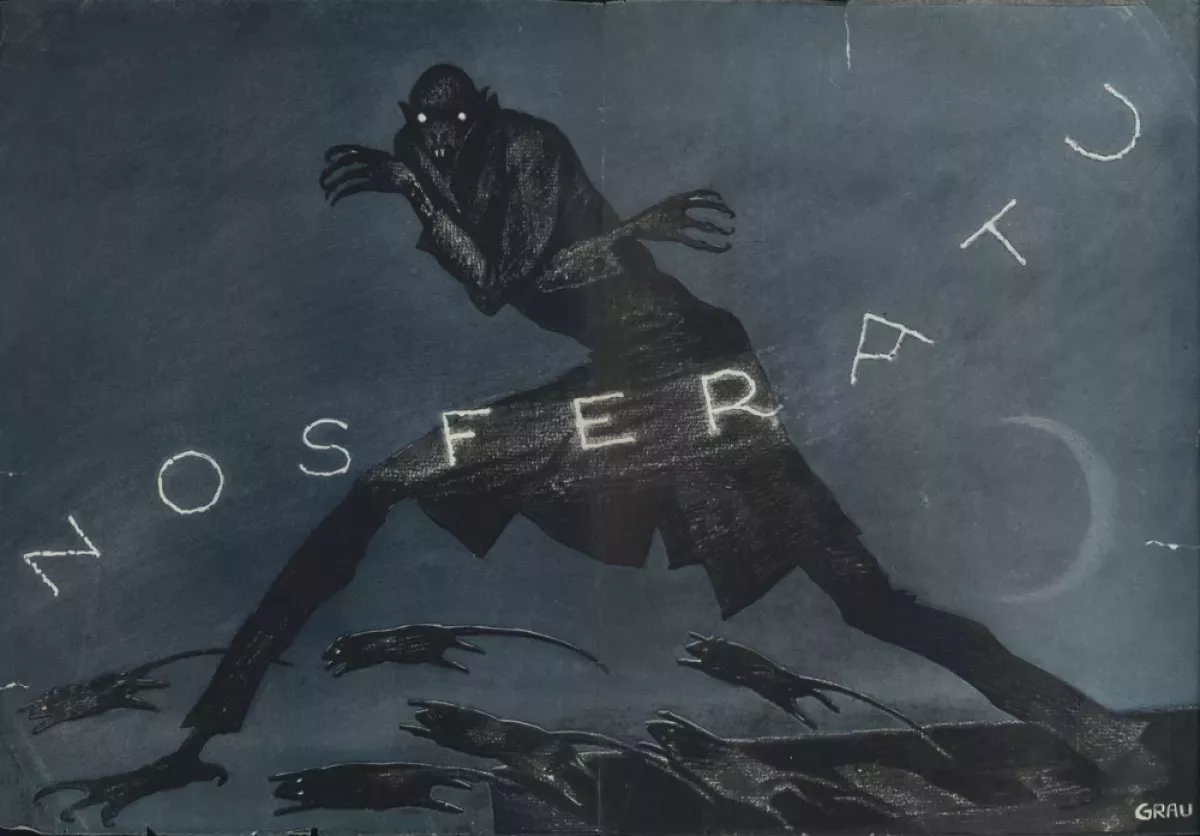"Nosferatu: A Symphony of Horror" is a 1922 silent German Expressionist horror film directed by F. W. Murnau. The film features Max Schreck as the menacing Count Orlok, a vampire who sets his sights on the wife of his real estate agent, Hutter, and unleashes a plague upon their town. Considered a masterpiece of German Expressionism, "Nosferatu" is renowned for its chilling atmosphere, haunting imagery, and Schreck's unforgettable performance as the grotesque and terrifying Count Orlok.
1907: Publication of Die Elixiere des Teufels
E. T. A. Hoffmann's Die Elixiere des Teufels, a text with esoteric themes that influenced Grau's visual style, was published in 1907.
1913: The Student of Prague Released
Henrik Galeen, who would later work on the screenplay for Nosferatu, contributed to the film The Student of Prague, released in 1913.
1916: Grau's Inspiration for a Vampire Film
Albin Grau shared an account of an experience during the winter of 1916, where a Serbian farmer claimed his father was a vampire. This encounter served as inspiration for Grau's vision of a vampire film.
1920: The Golem: How He Came into the World Released
Henrik Galeen penned the screenplay for The Golem: How He Came into the World, a film released in 1920. Galeen's experience with dark romanticism would later be evident in his work on Nosferatu.
July 1921: Filming Begins for Nosferatu
Principal photography for Nosferatu commenced in July 1921, with exterior shots taking place in various locations, including Wismar, Lübeck, Lauenburg, Rostock, Sylt, and the High Tatras region of Slovakia.
1921: Prana Film Founded
Enrico Dieckmann and Albin Grau established Prana Film, a German film studio, in 1921. The studio aimed to produce films with occult and supernatural themes.
February 1922: Nosferatu Opens in the Netherlands
Nosferatu premiered in the Netherlands on February 16, 1922, at the Hague Flora and Olympia cinemas.
March 1922: Nosferatu Premiere and Public Reception
Following its premiere in March 1922, Nosferatu garnered significant attention. The press widely covered the film, with some critics praising its technical aspects and others questioning the suitability of its visual clarity for a horror film.
March 1922: Nosferatu Premieres in Germany
Nosferatu premiered in Germany with a society event on March 4, 1922, at the Berlin Zoological Garden, followed by its cinema premiere on March 15, 1922, at Berlin's Primus-Palast.
1922: Nosferatu: A Symphony of Horror Release
The silent German Expressionist vampire film Nosferatu: A Symphony of Horror, directed by F. W. Murnau, was released in 1922. The film starred Max Schreck as the iconic vampire Count Orlok.
1922: Themes and Possible Undertones in Nosferatu
Upon its release in 1922, Nosferatu garnered attention for its themes exploring the fear of the Other and potential anti-Semitic undertones, possibly influenced by the source material, Bram Stoker's Dracula.
May 1930: Release of "Die zwölfte Stunde – Eine Nacht des Grauens"
May 1930 saw the unauthorized release of "Die zwölfte Stunde – Eine Nacht des Grauens", a re-edited, sound-on-disc version of Nosferatu. This version featured a different ending, renamed characters, and included scenes not previously released.
1977: Release of "Manuscrito encontrato en Zarazwela"
Spanish filmmaker José Ernesto Díaz Noriega released his humorous adaptation of Nosferatu, titled "Manuscrito encontrato en Zarazwela" or "Nos fera tu la pugnete," in 1977. This version incorporated dialogues and adapted the plot to reflect the Spanish transition to democracy.
1979: Release of Werner Herzog's "Nosferatu the Vampyre"
In 1979, Werner Herzog released his remake of Nosferatu, titled "Nosferatu the Vampyre," featuring Klaus Kinski as Count Dracula.
June 1981: Screening at Cinémathèque Française
In June 1981, "Die zwölfte Stunde – Eine Nacht des Grauens", the unauthorized sound version of Nosferatu, was screened at the Cinémathèque Française.
1981: Beginnings of Official Restorations
Starting in 1981, Nosferatu began to see various official restorations, several of which have been released on home video, each with its own copyright.
1993: Nosferatu Featured on Nickelodeon's "Are You Afraid of the Dark?"
In 1993, the iconic horror film Nosferatu was featured in an episode of the Nickelodeon series "Are You Afraid of the Dark?", introducing a new generation to the classic vampire tale.
1995: Reconstruction of Erdmann's Score Released
BMG Classics released a reconstructed version of Hans Erdmann's original score for Nosferatu in 1995. The reconstruction was done by musicologists and composers Gillian Anderson and James Kessler.
1995: Vatican's List of Important Films
In 1995, Nosferatu was included in the Vatican's list of 45 important films, signifying its cultural and artistic significance.
1997: James Bernard's Score Released
Silva Screen Records released James Bernard's score for Nosferatu in 1997.
2000: Release of "Shadow of the Vampire"
The year 2000 saw the release of "Shadow of the Vampire," a fictionalized account of the making of Nosferatu, directed by E. Elias Merhige.
2005: Release of David Lee Fisher's "The Cabinet of Dr. Caligari"
David Lee Fisher, known for his use of green screen technology, previously employed this technique in his 2005 remake of "The Cabinet of Dr. Caligari."
2005: Latest Restoration of Nosferatu
The most recent restoration of Nosferatu was completed between 2005 and 2006. This version features a reconstructed score and has been released on DVD and Blu-ray.
2006: Latest Restoration of Nosferatu
The most recent restoration of Nosferatu was completed between 2005 and 2006. This version features a reconstructed score and has been released on DVD and Blu-ray.
2010: Empire Magazine's "The 100 Best Films of World Cinema"
In 2010, Nosferatu secured the twenty-first position in Empire magazine's prestigious list of "The 100 Best Films of World Cinema," solidifying its place as a cinematic masterpiece.
December 2014: David Lee Fisher's Remake Funded on Kickstarter
David Lee Fisher's remake of Nosferatu was successfully funded on Kickstarter on December 3, 2014.
July 2015: Robert Eggers to Write and Direct Nosferatu Remake
July 2015 brought the exciting news that Robert Eggers, known for his distinct directorial style, would be helming a remake of Nosferatu, penning the script as well.
2015: Theft of F.W. Murnau's Skull
In a bizarre incident in 2015, the skull of F.W. Murnau, the director of Nosferatu, was stolen from his family tomb.
April 2016: Doug Jones Cast as Count Orlok, Filming Begins
On April 13, 2016, Doug Jones was announced as Count Orlok in David Lee Fisher's remake of Nosferatu, with filming commencing shortly after.
November 2016: Eggers Expresses Surprise at Nosferatu Being His Second Film
In a candid interview in November 2016, Robert Eggers shared his surprise that his Nosferatu remake would be his second feature film.
2017: Anya Taylor-Joy Joins Eggers' Nosferatu
In 2017, Anya Taylor-Joy was confirmed to star in Robert Eggers' Nosferatu, although her specific role remained undisclosed.
2019: Eggers Uncertain About Nosferatu Remake's Future
During a 2019 interview, Robert Eggers expressed uncertainty regarding the future of his Nosferatu remake, leaving fans and critics intrigued.
2019: Nosferatu Enters Public Domain
Nosferatu entered the public domain worldwide at the end of 2019. Prior to this, the film had been circulating widely in a sped-up, unrestored format.
September 2022: Focus Features to Distribute Eggers' Nosferatu, Casting Announced
September 2022 saw the announcement that Focus Features would distribute Robert Eggers' Nosferatu remake. The news also revealed a star-studded cast, including Bill Skarsgård and Lily-Rose Depp.
2022: Jozef van Wissem's Nosferatu Score Released
Dutch composer Jozef van Wissem released a new score and record for Nosferatu in 2022.
2022: "Phantoms of the Night. 100 Years of "Nosferatu" Exhibition"
In 2022, Berlin commemorated the centenary of Nosferatu with an exhibition titled "Phantoms of the Night. 100 Years of "Nosferatu."
2022: Release of "F.W.M. Symphony"
Released in late 2022, the short film "F.W.M. Symphony" pays homage to Nosferatu and incorporates the real-life theft of director F.W. Murnau's skull from his grave in 2015.
May 19, 2023: Completion of Principal Photography for Robert Eggers' "Nosferatu"
Robert Eggers' highly anticipated remake of Nosferatu concluded its principal photography on May 19, 2023.
October 2023: New Score for Nosferatu Premieres
Sebastian Chang's new score for Nosferatu, commissioned by the Louisville Orchestra, premiered in October 2023.
2023: Premiere of David Lee Fisher's "Nosferatu"
As of 2023, David Lee Fisher's remake of Nosferatu had premiered at the Emagine Theater in Novi and is slated for a limited release despite not securing a distributor.
June 24, 2024: Release of the First Teaser Trailer for Robert Eggers' "Nosferatu"
The first teaser trailer for Robert Eggers' remake of Nosferatu was released on June 24, 2024, heightening anticipation for the film's release.
December 25, 2024: Scheduled Release Date for Robert Eggers' "Nosferatu"
Mark your calendars: Robert Eggers' reimagining of Nosferatu is set to hit theaters on December 25, 2024.
Mentioned in this timeline

Anya Taylor-Joy is an actress known for her roles in...
Germany officially the Federal Republic of Germany is a Western...

News encompasses information about current events disseminated through various media...
The Netherlands is a country located in Northwestern Europe and...

An empire is a political structure consisting of a dominant...

Gillian Anderson is an American actress renowned for her diverse...
Trending

3 months ago Trey McBride impact on Cardinals, Kyler Murray's fantasy football implications, Colts game.

2 months ago Joe Flacco's Status Questionable for Bengals vs. Bears Game, Planning to Start

7 months ago Jennifer Garner and John Miller share passionate kiss; Ben Affleck spotted solo.
Alex Highsmith is a professional American football linebacker currently playing for the Pittsburgh Steelers in the NFL Before joining the...

6 months ago Drake Maye and Wife Ann Michael Donate Wedding Gifts to Local Shelter
Jaylen Waddle is a professional American football wide receiver currently playing for the Miami Dolphins in the NFL He was...
Popular

XXXTentacion born Jahseh Dwayne Ricardo Onfroy was a controversial yet...

Stranger Things created by the Duffer Brothers is a popular...
The Kennedy Center Honors are annual awards recognizing individuals and...
Turning Point USA TPUSA is an American nonprofit organization founded...

Candace Owens is an American conservative political commentator and author...

William Franklin Graham III commonly known as Franklin Graham is...
